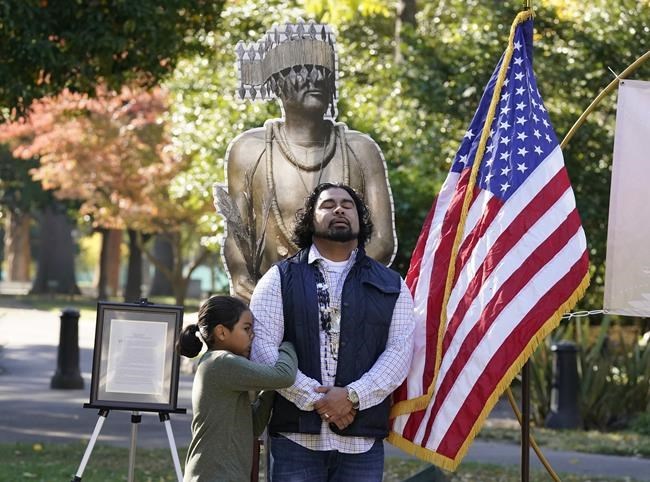
Jesse Tarango, right, chairman of Wilton Rancheria, is hugged by his son Jesse while standing in front of a enlarged photo of a statue of the late William Franklin Sr. during a groundbreaking ceremony for a Native American monument at Capitol Park in Sacramento, Calif., Monday, Nov. 14, 2022. The actual statue of Franklin will replace a statue of Fr. Junipero Serra whose statue was torn down by protesters in 2020. The new statue is expected to be placed in the park in early 2023. (AP Photo/Photo/Rich Pedroncelli)
November 14, 2022 - 2:21 PM
SACRAMENTO, Calif. (AP) — Long before California got its name, the Miwok Indians hunted and fished along the banks of what would become known as the Sacramento River — including a spot where the state Capitol now stands surrounded by dozens of monuments to the state's history.
Now, that tribe and others like it will have a monument for the first time honoring their history — a recognition made possible by protesters who tore down the statue of a Spanish missionary two years ago in a moment that coincided with a reassessment of California's past.
State and tribal officials gathered Monday to break ground on a statue of the late William Franklin Sr., a well-known member of the Miwok tribe who worked to preserve the tribe culture, including its traditional dances. The statue will replace one of the Rev. Junipero Serra, a Roman Catholic priest who built missions from San Diego to San Francisco with the aim of converting native peoples to Christianity.
Serra's legacy in California has been reevaluated in recent decades in light of the many native peoples who were forced to live and work at the missions, where they endured physical abuse. Thousands died.
In the summer of 2020, in the aftermath of the killing of George Floyd by a white police officer in Minnesota, protesters tore down the Serra statue at the California Capitol, along with statues in San Francisco and Los Angeles.
Last year, Democratic Gov. Gavin Newsom signed a law to replace the statue with a monument to California's Native American tribes.
“For us, this monument is more than just correcting a moment in history," said Regina Cuellar, chair of the Shingle Springs Band of Miwok Indians. “It is my hope that this acknowledgement to California's tribes will highlight the importance and further secure the inclusion of native voices in all matters of the state.”
The statue is one of several changes to how the state recognizes its history. Since the summer of 2020, state officials have also removed a statue of Christopher Columbus from the state Capitol and passed a law to rename every place that uses the word “squaw."
They also voted to rename the UC Hastings College of Law, which was named after Serranus Clinton Hastings, a former chief justice of the California Supreme Court who helped finance campaigns by white settlers to kill and enslave members of the Yuki Indian tribe.
Democratic Assemblymember James Ramos, the only Native American in the state Legislature, said Monday he was acting “as the voice of our ancestors that are still crying out from the grounds from the state of California."
“Once this new monument is completed, it will serve to remind students and all visitors to this historic Capitol Park that Native Americans lived on this land — and cared for it — long before California statehood and its preceding eras,” Ramos said.
News from © The Associated Press, 2022